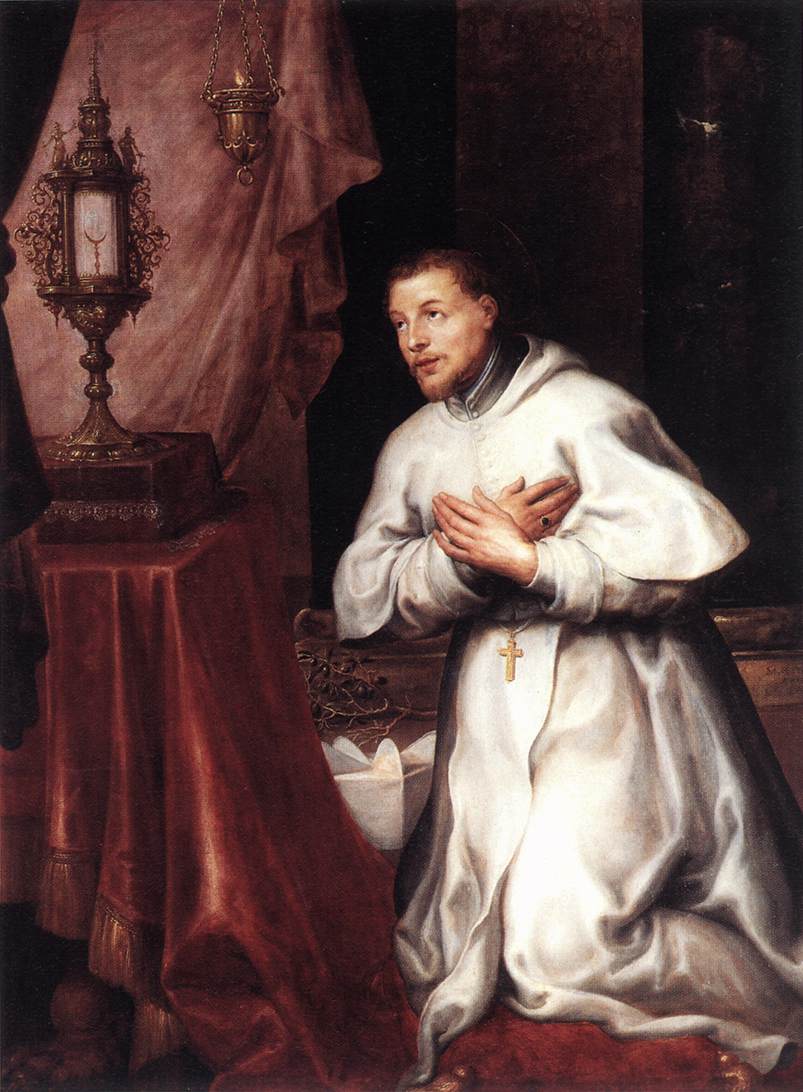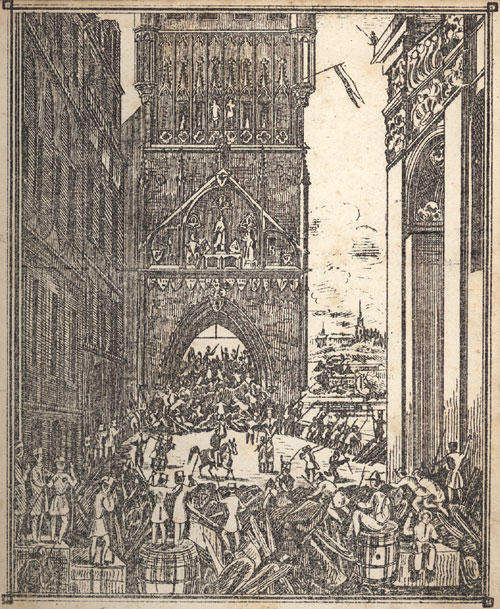|
Statues Of Saints Norbert, Wenceslaus And Sigismund
The statues of Saints Norbert, Wenceslaus and Sigismund are outdoor sculptures installed on the north side of the Charles Bridge in Prague, Czech Republic. They were created by Josef Max Josef Calanza Max (16 January 1804, Janov – 18 June 1855, Prague) was a German-Czech sculptor. His brother was the sculptor Emanuel Max. Life Max came from a family of sculptors and woodcarvers and received his first lessons from his father .... External links * Christian sculptures Monuments and memorials in Prague Sculptures of men in Prague Statues on the Charles Bridge Wenceslaus I, Duke of Bohemia {{CzechRepublic-sculpture-stub ... [...More Info...] [...Related Items...] OR: [Wikipedia] [Google] [Baidu] |
Josef Max
Josef Calanza Max (16 January 1804, Janov – 18 June 1855, Prague) was a German-Czech sculptor. His brother was the sculptor Emanuel Max. Life Max came from a family of sculptors and woodcarvers and received his first lessons from his father. In 1822, encouraged by letters from one of his father's former students, he moved to Prague, where he found employment in a woodcarving workshop. From 1823 to 1824, he studied at the Academy of Fine Arts under Joseph Bergler. He continued working for the woodcarving shop and married the owner's daughter, Anna Maria Schuhmann, in 1834. They had seven children, including the painter Gabriel Max and the photographer/painter Jindřich Břetislav Max (1847–1900).Karel Vavřínek, ''Almanach českých šlechtických a rytířských rodů 2008'' (Almanac of Czech Noble Families) Martin, Brandýs nad Labem (2007) pg.483 He began to exhibit as early as 1826, but received little recognition except for an award from the Academy for his statue of ... [...More Info...] [...Related Items...] OR: [Wikipedia] [Google] [Baidu] |
Norbert Of Xanten
Norbert of Xanten, O. Praem (c. 1075 – 6 June 1134) (Xanten-Magdeburg), also known as Norbert Gennep, was a bishop of the Catholic Church, founder of the Premonstratensian order of canons regular, and is venerated as a saint. Norbert was canonized by Pope Gregory XIII in the year 1582, and his statue appears above the Piazza colonnade of St. Peter's Square in Rome. Early priesthood He adopted such strict discipline that it killed his first three disciples. This may be why he failed to reform the canons of Xanten, who denounced him as an innovator at the Council of Fritzlar in 1118. He then resigned his benefice, sold all his property and gave the proceeds to the poor. He visited Pope Gelasius II, who gave him permission to become an itinerant preacher and he preached throughout lands in what is now western Germany, Belgium, the Netherlands and northern France, being credited with a number of miracles. In settlement after settlement he encountered a demoralized clergy, lone ... [...More Info...] [...Related Items...] OR: [Wikipedia] [Google] [Baidu] |
Wenceslaus I, Duke Of Bohemia
Wenceslaus I ( cs, Václav ; c. 907 – 28 September 935 or 929), Wenceslas I or ''Václav the Good'' was the Duke ('' kníže'') of Bohemia from 921 until his death, probably in 935. According to the legend, he was assassinated by his younger brother, Boleslaus the Cruel. His martyrdom and the popularity of several biographies gave rise to a reputation for heroic virtue that resulted in his sainthood. He was posthumously declared to be a king and patron saint of the Czech state. He is the subject of the well-known "Good King Wenceslas", a carol for Saint Stephen's Day. Biography Wenceslaus was the son of Vratislaus I, Duke of Bohemia from the Přemyslid dynasty. His grandfather, Bořivoj I of Bohemia, was converted to Christianity by Cyril and Methodius. His mother, Drahomíra, was the daughter of a pagan tribal chief of the Havelli, but was baptized at the time of her marriage. His paternal grandmother, Ludmila of Bohemia, saw to it that he was educated in the Old Slavonic ... [...More Info...] [...Related Items...] OR: [Wikipedia] [Google] [Baidu] |
Sigismund Of Burgundy
Sigismund ( la, Sigismundus; died 524 AD) was King of the Burgundians from 516 until his death. He was the son of king Gundobad and Caretene. He succeeded his father in 516. Sigismund and his brother Godomar were defeated in battle by Clovis's sons, and Godomar fled. Sigismund was captured by Chlodomer, King of Orléans, where he was kept as a prisoner. Later he, his wife and his children were executed. Godomar then rallied the Burgundian army and won back his kingdom. Life Sigismund was a student of Avitus of Vienne, the Chalcedonian bishop of Vienne who converted Sigismund from the Arian faith of his Burgundian forebears. Sigismund was inspired to found a monastery dedicated to Saint Maurice at Agaune in Valais in 515. The following year he became king of the Burgundians. Sigismund's conflict with Bishop Apollinaris Sigismund came into conflict with Apollinaris of Valence over the rules regarding marriage. The king's treasurer, Stephen, was living in flagrant incest. The ... [...More Info...] [...Related Items...] OR: [Wikipedia] [Google] [Baidu] |
Prague
Prague ( ; cs, Praha ; german: Prag, ; la, Praga) is the capital and largest city in the Czech Republic, and the historical capital of Bohemia. On the Vltava river, Prague is home to about 1.3 million people. The city has a temperate oceanic climate, with relatively warm summers and chilly winters. Prague is a political, cultural, and economic hub of central Europe, with a rich history and Romanesque, Gothic, Renaissance and Baroque architectures. It was the capital of the Kingdom of Bohemia and residence of several Holy Roman Emperors, most notably Charles IV (r. 1346–1378). It was an important city to the Habsburg monarchy and Austro-Hungarian Empire. The city played major roles in the Bohemian and the Protestant Reformations, the Thirty Years' War and in 20th-century history as the capital of Czechoslovakia between the World Wars and the post-war Communist era. Prague is home to a number of well-known cultural attractions, many of which survived the ... [...More Info...] [...Related Items...] OR: [Wikipedia] [Google] [Baidu] |
Charles Bridge
Charles Bridge ( cs, Karlův most ) is a medieval stone arch bridge that crosses the Vltava river in Prague, Czech Republic. Its construction started in 1357 under the auspices of King Charles IV, and finished in the early 15th century.; The bridge replaced the old Judith Bridge built 1158–1172 that had been badly damaged by a flood in 1342. This new bridge was originally called Stone Bridge (''Kamenný most'') or Prague Bridge (''Pražský most''), but has been referred to as "Charles Bridge" since 1870. As the only means of crossing the river Vltava until 1841, Charles Bridge was the most important connection between Prague Castle and the city's Old Town and adjacent areas. This land connection made Prague important as a trade route between Eastern and Western Europe. The bridge is long and nearly wide. Following the example of the Stone Bridge in Regensburg, it was built as a bow bridge with 16 arches shielded by ice guards. It is protected by three bridge towers, two ... [...More Info...] [...Related Items...] OR: [Wikipedia] [Google] [Baidu] |
Christian Sculptures
Christians () are people who follow or adhere to Christianity, a monotheistic Abrahamic religion based on the life and teachings of Jesus Christ. The words ''Christ'' and ''Christian'' derive from the Koine Greek title ''Christós'' (Χριστός), a translation of the Biblical Hebrew term ''mashiach'' (מָשִׁיחַ) (usually rendered as ''messiah'' in English). While there are diverse interpretations of Christianity which sometimes conflict, they are united in believing that Jesus has a unique significance. The term ''Christian'' used as an adjective is descriptive of anything associated with Christianity or Christian churches, or in a proverbial sense "all that is noble, and good, and Christ-like." It does not have a meaning of 'of Christ' or 'related or pertaining to Christ'. According to a 2011 Pew Research Center survey, there were 2.2 billion Christians around the world in 2010, up from about 600 million in 1910. Today, about 37% of all Christians live in the Amer ... [...More Info...] [...Related Items...] OR: [Wikipedia] [Google] [Baidu] |
Monuments And Memorials In Prague
A monument is a type of structure that was explicitly created to commemorate a person or event, or which has become relevant to a social group as a part of their remembrance of historic times or cultural heritage, due to its artistic, historical, political, technical or architectural importance. Some of the first monuments were dolmens or menhirs, megalithic constructions built for religious or funerary purposes. Examples of monuments include statues, (war) memorials, historical buildings, archaeological sites, and cultural assets. If there is a public interest in its preservation, a monument can for example be listed as a UNESCO World Heritage Site. Etymology It is believed that the origin of the word "monument" comes from the Greek ''mnemosynon'' and the Latin ''moneo'', ''monere'', which means 'to remind', 'to advise' or 'to warn', however, it is also believed that the word monument originates from an Albanian word 'mani men' which in Albanian language means 'remember ... [...More Info...] [...Related Items...] OR: [Wikipedia] [Google] [Baidu] |
Sculptures Of Men In Prague
Sculpture is the branch of the visual arts that operates in three dimensions. Sculpture is the three-dimensional art work which is physically presented in the dimensions of height, width and depth. It is one of the plastic arts. Durable sculptural processes originally used carving (the removal of material) and modelling (the addition of material, as clay), in stone, metal, ceramics, wood and other materials but, since Modernism, there has been an almost complete freedom of materials and process. A wide variety of materials may be worked by removal such as carving, assembled by welding or modelling, or moulded or cast. Sculpture in stone survives far better than works of art in perishable materials, and often represents the majority of the surviving works (other than pottery) from ancient cultures, though conversely traditions of sculpture in wood may have vanished almost entirely. However, most ancient sculpture was brightly painted, and this has been lost. [...More Info...] [...Related Items...] OR: [Wikipedia] [Google] [Baidu] |
Statues On The Charles Bridge
A statue is a free-standing sculpture in which the realistic, full-length figures of persons or animals are carved or cast in a durable material such as wood, metal or stone. Typical statues are life-sized or close to life-size; a sculpture that represents persons or animals in full figure but that is small enough to lift and carry is a statuette or figurine, whilst one more than twice life-size is a colossal statue. Statues have been produced in many cultures from prehistory to the present; the oldest-known statue dating to about 30,000 years ago. Statues represent many different people and animals, real and mythical. Many statues are placed in public places as public art. The world's tallest statue, ''Statue of Unity'', is tall and is located near the Narmada dam in Gujarat, India. Color Ancient statues often show the bare surface of the material of which they are made. For example, many people associate Greek classical art with white marble sculpture, but there is evidenc ... [...More Info...] [...Related Items...] OR: [Wikipedia] [Google] [Baidu] |








